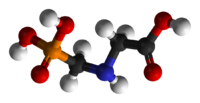
Photo from wikipedia
The massive and careless use of glyphosate (GLY) in agricultural production raises many questions regarding environmental pollution and health risks, it is then important to develop simple methods to detect… Click to show full abstract
The massive and careless use of glyphosate (GLY) in agricultural production raises many questions regarding environmental pollution and health risks, it is then important to develop simple methods to detect it. Electrochemical impedance spectroscopy (EIS) is an effective analytical tool for characterizing properties at the electrode/electrolyte interface. It is useful as an analytical procedure, but it can also help in the interpretation of the involved fundamental electrochemical and electronic processes. In this study, the impedance data obtained experimentally for a microsensor based on molecularly imprinted chitosan graft on 4-aminophenylacetic acid for the detection of glyphosate was analyzed using an exact mathematical model based on physical theories. The procedure for modeling experimental responses is well explained. The analysis of the observed impedance response leads to estimations of the microscopic parameters linked to the faradic and capacitive current. The interaction of glyphosate molecules with the imprinted sites of the CS-MIPs film is observed in the high frequency range. The relative variation of the charge transfer resistance is proportional to the log of the concentration of glyphosate. The capacitance decreases as the concentration of glyphosate increases, which is explained by the discharging of the charged imprinted sites when the glyphosate molecule interacts with the imprinted sites through electrostatic interactions. The phenomenon of adsorption of the ions in the CMA film is observed in the low frequency range, this phenomenon being balanced by the electrostatic interaction of glyphosate with the imprinted sites in the CS-MIPs film.
Journal Title: Molecules
Year Published: 2022
Link to full text (if available)
Share on Social Media: Sign Up to like & get
recommendations!